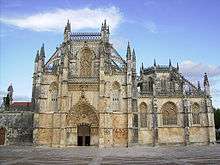Portuguese pavement
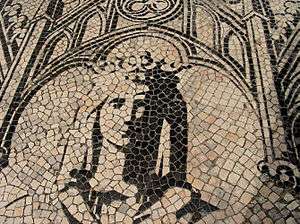
Portuguese pavement (calçada portuguesa, European Portuguese: [kɐɫˈsaðɐ puɾtuˈɣezɐ], Brazilian Portuguese: [kawˈsadɐ poʁtuˈɡezɐ]) is a traditional-style pavement used for many pedestrian areas in Portugal. It consists of small flat pieces of stones arranged in a pattern or image, like a mosaic. It can also be found in Olivença (a disputed territory administered by Spain) and throughout old Portuguese colonies, such as Brazil and Macau. Portuguese workers are also hired for their skill in creating these pavements in places such as Gibraltar. Being usually used in sidewalks, it is in squares and atriums that this art finds its deepest expression.
One of the most distinctive uses of this paving technique is the image of Saint Elizabeth of Portugal, (Santa Rainha Isabel) in Coimbra, designed with black and white stones of basalt and limestone.
Origins
Paving as a craft is believed to have originated in Mesopotamia, where rocky materials were used in the inside and outside of constructions, being later brought to Ancient Greece and Ancient Rome.
The Romans used to pave the vias connecting the empire using materials to be found in the surroundings. Some of the techniques introduced then are still applied on the calçada, most noticeably the use of a foundation and a surfacing.
Future

Very little new paving is done and the entire profession is at risk. The long hours and low wages typical of calceteiros have reduced apprenticeships and thus new pavers. Furthermore, as the pavement is less safe (provides less traction when wet; loose stones can become tripping hazards), costs more (especially with the difficulty of obtaining appropriate stones), and wears quicker than concrete or asphalt, there is also dropping interest in investment and construction in it. Although there were once hundreds of calceteiros, most modern work is on conservation or major architectural projects.
While São Paulo is currently replacing the Portuguese pavement sidewalks of Paulista Avenue with a cheaper type of pavement, other Brazilians cities such as Rio de Janeiro still have nearly ubiquitous Portuguese pavement, particularly in more affluent areas.
Setting the stones
Craftsmen lay a bedding of gravel upon a well-compacted trench of argillaceous materials, which accommodates the tessera stones, acting as a cement.


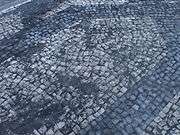

Calçada as a form of art
 Stars in Lisbon
Stars in Lisbon- Portuguese pavement in Copacabana Beach, Rio de Janeiro
- Póvoa de Varzim's runes in Praça do Almada


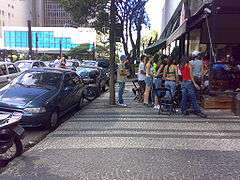 A sidewalk next to Paulista Avenue, a whole neighbourhood that used to have its sidewalks entirely paved by Portuguese pavement, in São Paulo, Brazil
A sidewalk next to Paulista Avenue, a whole neighbourhood that used to have its sidewalks entirely paved by Portuguese pavement, in São Paulo, Brazil



 Transistor symbol drawn in University of Aveiro
Transistor symbol drawn in University of Aveiro Plaza de España, Olivença
Plaza de España, Olivença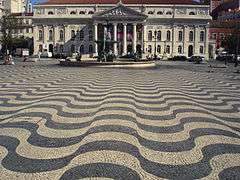 Pavement on the Rossio Square (Praça do Rossio), Lisbon
Pavement on the Rossio Square (Praça do Rossio), Lisbon Pavement in Ocean Village Gibraltar
Pavement in Ocean Village Gibraltar
See also
External links
| Wikimedia Commons has media related to Portuguese pavement. |
- Paving in Portuguese, urbanphoto.net
- Portuguese pavement and its histories (Portuguese language)
- The Portuguese Pavements Handbook (10 MB), Direccção Nacional de Energia e Geologia (Portuguese/English)
